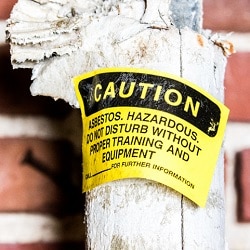
Asbestos: Client caught unawares by notice
A licensed conveyancer who lied to a client and fabricated a letter to him, lied to her law firm about it and then lied again to her regulator has been disqualified for 10 years.
A Council for Licensed Conveyancers (CLC) adjudication panel said only disqualification would reflect the seriousness of Gemma Taylor’s “pattern of dishonest behaviour”, but stopped short of making it permanent.
The panel heard that Ms Taylor joined ‘Firm A’ as an associate in the residential conveyancing department in 2018, and was promoted to partner in 2021.
She had been instructed by ‘Client A’ in September 2020 to act on his purchase of a flat, a transaction which completed in December 2020.
Client A wrote to Ms Taylor in January 2022, querying a notice received under section 20 of the Landlord and Tenant Act 1985, “relating to the removal of asbestos items in the exterior of the flat, and the fitting of replacement plastic items”.
The notice was sent by the local authority and would involve him being charged. He asked Ms Taylor why she had not advised him on a similar notice served on the sellers of his flat in August 2020.
Ms Taylor replied on the same day, confirming they had a copy of the notice as part of the management pack “which I requested to be forwarded on to you as it arrived during my absence. I hope this was sent to you, but if not I sincerely apologise now”.
Client A said he had not seen it and asked for proof it had been sent. She forwarded a copy of the letter she claimed was sent but it later emerged she had just created it.
Client A complained to the firm, saying he had incurred losses of just over £6,000. The firm made good his loss.
Initially, Ms Taylor told her senior partner that the letter had genuinely been written in November 2020 but, the following day, admitted falsifying it, saying she had been suffering from “high levels of stress”.
She was dismissed for gross misconduct and her misconduct reported to both the CLC and Solicitors Regulation Authority.
In mitigation, Ms Taylor said her actions were out of character and resulted from the “immense workloads and pressure” under which she and the department were working. This led her to make a “spur of the moment” decision which she deeply regretted.
She started a new job as head of residential property at another firm very shortly after her dismissal.
When submitting to the CLC first a notice of change of employment and later in the year her licence renewal form, she falsely declared that she had not been the subject of a disciplinary investigation by her past or current employer and had not been dismissed.
She told the panel that these were simple errors as she had not read the forms properly.
The panel found it likely that Ms Taylor “did panic, and did act initially on the spur of the moment”, but there was ultimately sufficient time “to realise that what she was doing was dishonest”.
It rejected too her assertion that both CLC forms were inaccurately completed through haste and complacency.
The panel said that, given the “pattern of dishonest behaviour”, there was a likelihood her misconduct would be repeated.
It found that “a good deal” of Ms Talor’s regret and remorse “appeared to focus on the impact on the respondent herself and those around her” and there was “no evidence of insight”.
However, having failed to self-report to the CLC, she had co-operated with the investigation. The panel took into account the impact of the disciplinary proceedings but said there was no medical evidence in support of “assertions relating to her health”.
The panel considered permanent disqualification, but said it was not necessary, partly because none of the allegations related to misappropriation of client money. While there was a “pattern”, the misconduct was not “sustained over a prolonged period”.
Ms Taylor had made “calculated decisions”, but these were “in effect attempts to ‘cover her tracks’ after making a mistake in failing to advise a client properly”.
She was disqualified for 10 years, fined £1,500 and ordered to pay costs of £3,525.














Leave a Comment